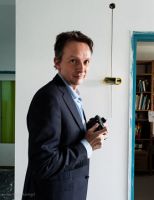
Philip Habing

Plane division and the role of the Roskam
Sometime in 1980, when I was in 4VWO, my dear friend Alexander Verbeek suggested that we sign up as lay-outers of the Roskam. Under the guidance of a very strict Wil Jaski (and I believe Sandrien Lammers) we had to classify patterns, we learned that headlines had to be set in sans-serif Helvetica and Futura and exactly what widows and orphans were. Alexander and I became addicted to designing. I don’t think we really understood what the function of design was, but in the years after Jaski we fully indulged ourselves on the flat surface of the Roskam. The art of two-dimensional placement has not let go of me.
‘If you’re gloomy, you better do something with it’, a philosophical roommate in Delft had told me when I was in another depressed mood. One day, meditating on the tram to The Hague, I bought a camera, completely on a whim; it cost me my entire monthly allowance. The camera fascinated me: I could capture time. In that first week of photography, I shot a series of clumsy self-portraits with the intention of at least knowing what I looked like when I was gloomy. Being able to press a button and hold a flat piece of paper with an image on it a few hours later in the darkroom became a pleasant pastime. I honestly have no idea why it was so helpful to know what I looked like when I was depressed, as I never did anything with those pictures.
In the years that followed, a photographer friend from Delft sent me to the run-down Schilderswijk in The Hague. We both completely agreed with photographer Ed van der Elsken who thought that ‘beauty can be around the corner’. And so my friend thought that I should make a few ‘Van Der Elskens’ with a wide-angle lens in this pauper area.
Looking back, I have come to see that these photos of children playing among condemned houses are also about placement in a plane. I found that a photo should definitely be an unusual composition. I placed Turkish-speaking children half in the picture, a boy with a brown tooth in his mouth (and a lollipop) demonstrated how he could chop someone’s head off with his shovel: my picture shows a funny-looking little man and in particular a flying shovel, from my point of view just over the houses. What I had learned about design at the Rijnlands came to the surface again.
In the years between Delft and now I have continued to take pictures, in addition to my part-time job as a physics teacher. I found it difficult to choose and so I remained both a photographer and a teacher. Plane division and form versus content play an increasingly important role in my photography these days. In my free work I let go of the content very much and recently I have decided to give form the leading role it deserves in my wedding reports as well; sometimes it is a matter of just a few millimetres.
Philip Habing, April 2013